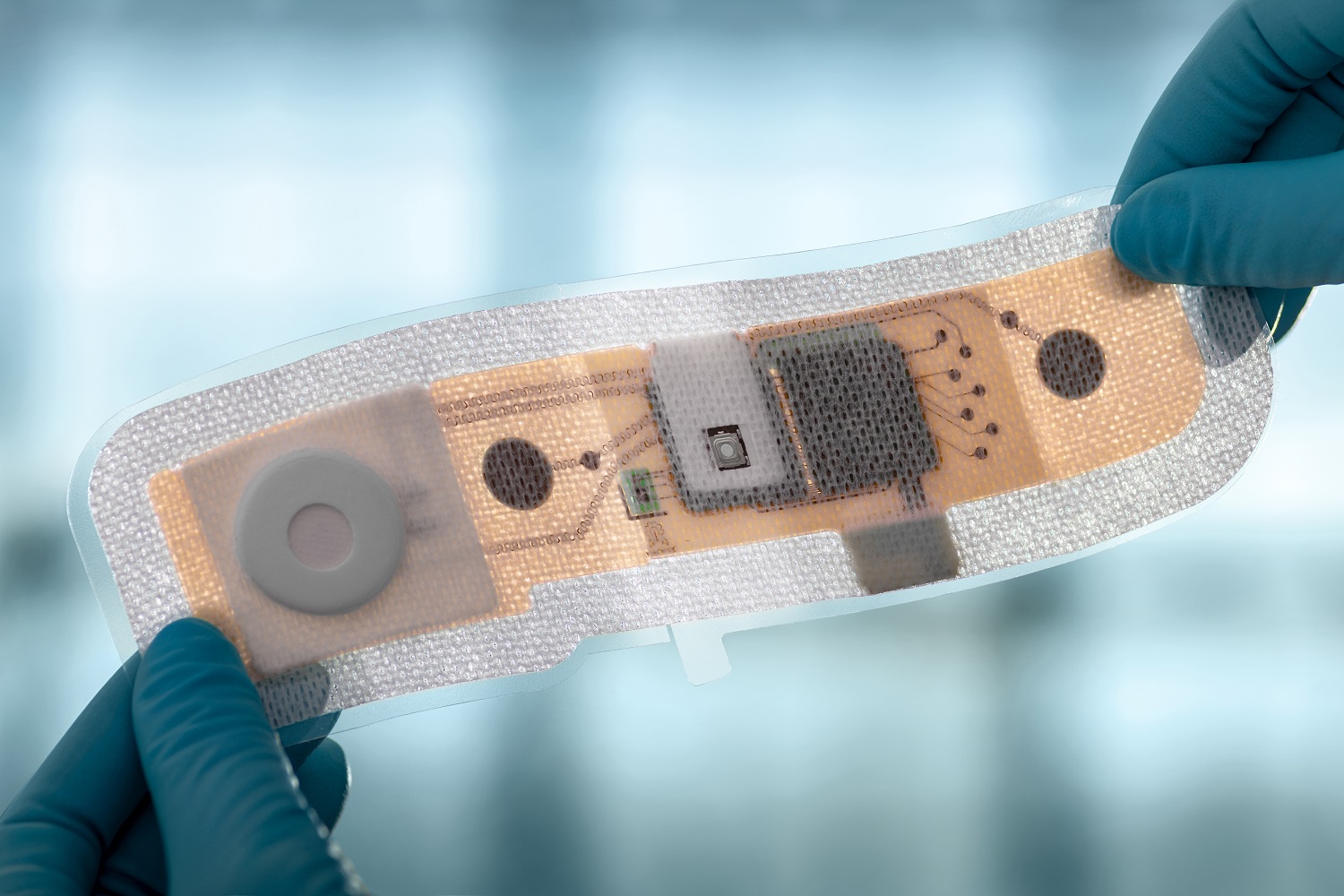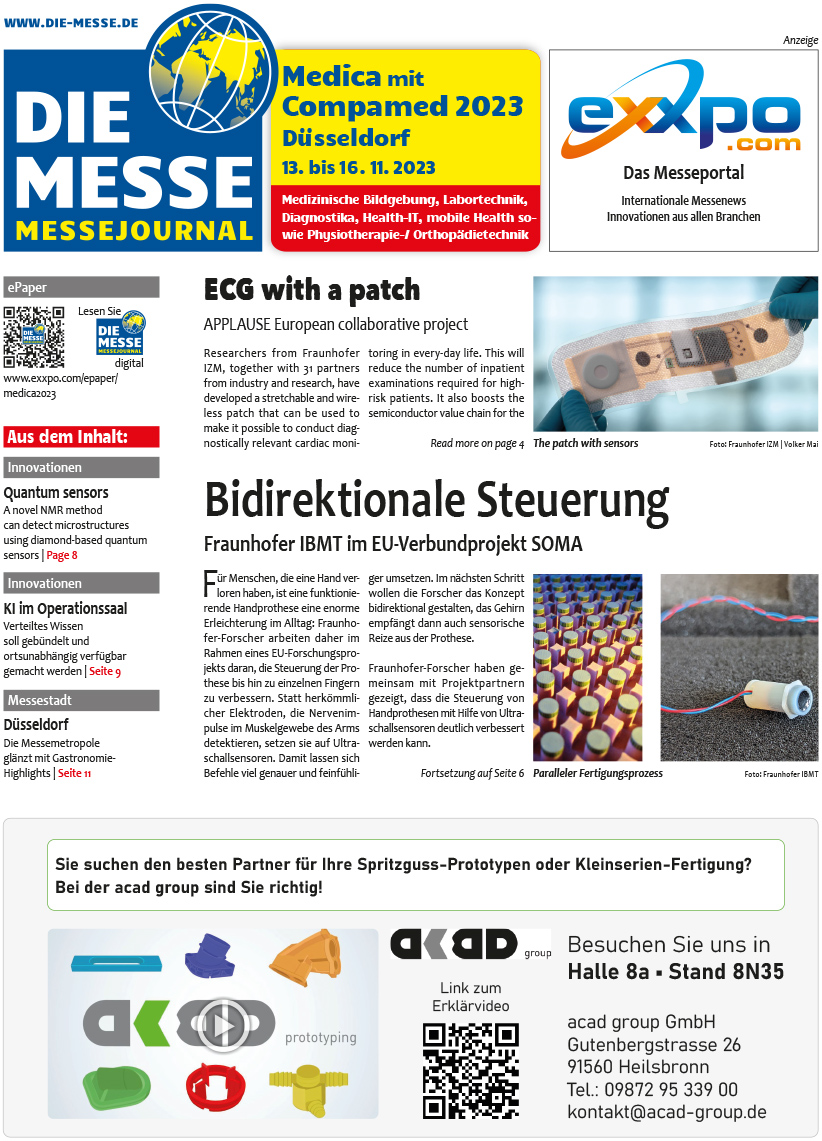13 November 2023
Tracking everyday fitness with smartwatches is now part of everyday life for many people. A glance at your smartphone can show you your pulse, step count, sleep quality or even heart rhythm. This kind of information on heart health can now be supplemented by much more complex health data and help with medical diagnoses. The demonstrator created as part of the European Union-funded ESCEL project APPLAUSE ("Advanced packaging for photonics, optics and electronics for low-cost manufacturing in Europe") is as thin as an ordinary plaster. Inside, it hides sensors and tiny electronics for long-term heart monitoring. Once stuck on, the Plug&Play patch can be used for cardiological monitoring of patients. This means that vital data such as oxygen saturation in the blood, chest movement and bio-impedance can be measured and transmitted directly to an app for monitoring by clinical staff. The researchers at Fraunhofer IZM have been focusing on system and circuit development, assembly and connection technology as well as the integration of a densely packed circuit carrier into the patch.
Improved comfort with TPU
Thermoplastic polyurethane (TPU) was used as the backing film for the patch, which is highly comfortable to wear on the body due to its flexibility and stretchability. The material can also be processed cost-effectively using common PCB technologies, such as the assembly of components with pick-and-place machines. This advantage was utilised through the integration of the electrical functionalities into a dual system-in-package (SiP) design, which was mounted directly on the flexible printed circuit board. Würth Elektronik Circuit Board Technology was involved in the design of the circuit boards and the production of the substrates. To achieve this, new ultra-flexible and rigid-flexible assembly variants were designed alongside project partner OSYPKA AG; the PCBs were manufactured using the skin-friendly substrates.
Integration technologies consistently developed
The project also showed the feasibility of robust encapsulation of thin circuit carriers equipped with components of different heights on TPU. The high level of miniaturisation and tight integration ultimately resulted in a very unobtrusive form factor, with the stretchable PCB providing a highly compliant and biocompatible substrate. Printing the electrodes directly on the flexible printed circuit board and integrating all the electronics into a textile substrate have been key advances in the development of medical patches for monitoring bodily functions. Christine Kallmayer, project manager at Fraunhofer IZM, expressed her satisfaction with the results: "A few years ago, an electronic patch like this for monitoring the heart would have been unimaginable. It has only been the advancement of integration technologies that mean it is now possible to miniaturise medical technology to the point where it can be used as a biocompatible and stretchable patch rather than a rigid device."
The APPLAUSE demonstrator and other research highlights from Ms Kallmayer's "System on Flex" group will be presented in Hall 8a / H29-2.
The project is part of the APPLAUSE project, which is funded by the European Union's Horizon 2020 research and innovation programme as part of the ECSEL Joint Undertaking to the tune of 34.5 million euros. Other project partners included Würth Elektronik Circuit Board Technology, the Interuniversitair Micro-Electronica Centrum (IMEC), Precordior OY, the Fraunhofer Institutes ENAS and IMS as well as 26 other European partners from industry and research, which are listed here: www.elektronikforschung.de/projekte/applause
ECG with a patch
Researchers from Fraunhofer IZM, together with 31 partners from industry and research, have developed a stretchable and wireless patch that can be used to make it possible to conduct diagnostically relevant cardiac monitoring in every-day life. This will reduce the number of inpatient examinations required for high-risk patients. It also boosts the semiconductor value chain for the medical sector in Europe through the development of new tools, methods and processes for series production.
 Foto: Fraunhofer IZM | Volker Mai Foto: Fraunhofer IZM | Volker MaiThe patch with sensors, electronics and battery can easily be stuck on the upper body |
Improved comfort with TPU
Thermoplastic polyurethane (TPU) was used as the backing film for the patch, which is highly comfortable to wear on the body due to its flexibility and stretchability. The material can also be processed cost-effectively using common PCB technologies, such as the assembly of components with pick-and-place machines. This advantage was utilised through the integration of the electrical functionalities into a dual system-in-package (SiP) design, which was mounted directly on the flexible printed circuit board. Würth Elektronik Circuit Board Technology was involved in the design of the circuit boards and the production of the substrates. To achieve this, new ultra-flexible and rigid-flexible assembly variants were designed alongside project partner OSYPKA AG; the PCBs were manufactured using the skin-friendly substrates.
Integration technologies consistently developed
The project also showed the feasibility of robust encapsulation of thin circuit carriers equipped with components of different heights on TPU. The high level of miniaturisation and tight integration ultimately resulted in a very unobtrusive form factor, with the stretchable PCB providing a highly compliant and biocompatible substrate. Printing the electrodes directly on the flexible printed circuit board and integrating all the electronics into a textile substrate have been key advances in the development of medical patches for monitoring bodily functions. Christine Kallmayer, project manager at Fraunhofer IZM, expressed her satisfaction with the results: "A few years ago, an electronic patch like this for monitoring the heart would have been unimaginable. It has only been the advancement of integration technologies that mean it is now possible to miniaturise medical technology to the point where it can be used as a biocompatible and stretchable patch rather than a rigid device."
The APPLAUSE demonstrator and other research highlights from Ms Kallmayer's "System on Flex" group will be presented in Hall 8a / H29-2.
The project is part of the APPLAUSE project, which is funded by the European Union's Horizon 2020 research and innovation programme as part of the ECSEL Joint Undertaking to the tune of 34.5 million euros. Other project partners included Würth Elektronik Circuit Board Technology, the Interuniversitair Micro-Electronica Centrum (IMEC), Precordior OY, the Fraunhofer Institutes ENAS and IMS as well as 26 other European partners from industry and research, which are listed here: www.elektronikforschung.de/projekte/applause
More news about "Medica":
21 September 2020
MEDICA and COMPAMED 2020 to be launched as ‘virtual.MEDICA’ and ‘virtual.COMPAMED’
MEDICA 2020 and COMPAMED 2020, the world-leading information and communication platforms for the medical technology industry and supplier industry for the medical technology industry, will take place entirely online from 16 to 19 November. Within the framework of 'virtual.MEDICA' and 'virtual.COMPAMED', decision-makers from all sectors of the healthcare industry can then expect a comprehensive range of products and services at virtual.MEDICA.de and virtual.COMPAMED.de consisting of three focal areas: The Conference Area (conference and forum program), the Exhibition Space (for exhibitors and product innovations) and the Networking Plaza (networking/ matchmaking). The next events, MEDICA 2021 and COMPAMED 2021, will be held as a hybrid event next year. The hybrid concept consists of combining live platforms for professional visitors to the Düsseldorf trade fair centre and digital offers. (more…)2 July 2020
The MEDICA, the world’s leading medical trade fair held in Düsseldorf, was one of the very first events across all industries to offer young companies in their founding phase special programme formats to present their concepts many years ago. It has subsequently become the international number one for health start-ups too. The creative and predominantly digitally driven start-up scene will be the centre of attention once again at MEDICA 2020 (run time: 16 to 19 November). This is because, following the Corona pandemic, mobile and easily applicable solutions for linking the actors in the healthcare system have become even more important. (more…)19 June 2020
Globally, no sector has been placed under the magnifying glass more than the healthcare sector due to the Corona pandemic. Hospitals, outpatient clinics, practice-based physicians and care facilities have experienced a sudden increased demand for medical and laboratory technology, a wide variety of medical products, digital health applications and, most of all, personal protective equipment. Under these conditions, the plans for the world’s biggest medical trade fair MEDICA 2020 and the number one trade fair for suppliers of the medical technology industry, COMPAMED 2020, held in parallel, are revving up to full throttle. Both events will take place from 16 to 19 November in Düsseldorf – closely interlinked with extensive digital offers and services. (more…)8 March 2019
Messe Düsseldorf India has acquired the FAMDENT Shows, one of the leading Indian fairs for dental medicine. This means the event will become a member of the MEDICAlliance, the umbrella brand for all global healthcare exhibition activities of the Messe Düsseldorf Group. (more…)28 January 2019
Medical Fair India with new “rehaindia” feature
From 21 – 23 February 2019 the Indian health industry elite will meet at the 25th Medical Fair India at the Pragati Maidon Exhibition Center in New Delhi. A new feature this year is rehaindia (powered by Rehacare) with ranges for rehabilitation and nursing care. (more…)
| FAIR NAVIGATOR PHARMA / MEDICAL TECHNOLOGY | |
|---|---|
|
| E-PAPER MEDICA |
 |
